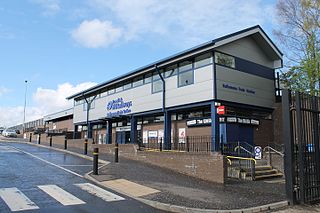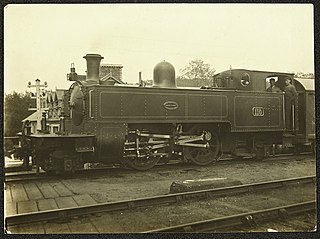
Ballyclare is a small town in County Antrim, Northern Ireland. It had a population of 9,953 according to the 2011 census, and is located within the Antrim and Newtownabbey Borough Council area.

The Ulster Transport Authority (UTA) ran rail and bus transport in Northern Ireland from 1948 until 1966.

The Northern Counties Committee (NCC) was a railway that served the north-east of Ireland. It was built to Irish gauge but later acquired a number of 914 mm narrow gauge lines. It had its origins in the Belfast and Ballymena Railway that opened to traffic on 11 April 1848.

Ballymena is a town in County Antrim, Northern Ireland. It is part of the Borough of Mid and East Antrim.

Doagh is a village and townland in County Antrim, Northern Ireland. It is in the Six Mile Water Valley, about two miles south-west of Ballyclare, and had a population of 1,388 people in the 2011 Census. It is known as Doach in Scots.

The A36 is a road in Northern Ireland. It travels through County Antrim, connecting the large towns of Ballymena and Larne.

The Northern Counties Committee (NCC) Class U2 4-4-0 passenger steam locomotives consisted of 18 locomotives built for service in north-east Ireland. Ten of the engines were new builds supplied by the North British Locomotive Company (NBL) or constructed at the NCC's York Road works. The remainder were rebuilds of existing locomotives.

Cargan is a hamlet and townland in County Antrim, Northern Ireland. It lies at the foot of Slievenanee in Glenravel – locally known as "The Tenth Glen" along with the more widely known nine Glens of Antrim. It is part of Mid and East Antrim district. It had a population of 588 people in the 2011 Census.
Martinstown is a small village in County Antrim, Northern Ireland. Located 6 miles from Ballymena, it is situated in Glenravel, locally known as "The Tenth Glen", alongside the widely known nine Glens of Antrim.

Ballymena railway station serves the town of Ballymena in County Antrim, Northern Ireland. It is located just outside Ballymena town centre on the Galgorm Road, and is integrated with the local bus station. It is situated on the Derry line between Antrim and Cullybackey. The station is operated by Northern Ireland Railways.

The Belfast and Northern Counties Railway (BNCR) Class S was a class of 2-4-2T two-cylinder compound steam locomotives that was introduced for service on the 3 ft narrow gauge railways of County Antrim in north-east Ireland.
The Northern Counties Committee (NCC) Class S1 was a class of two-cylinder compound 2-4-2T steam locomotives that was introduced for service on the 3 ft (914 mm) narrow gauge railways of County Antrim in north-east Ireland. The members of the class were rebuilds of the BNCR Class S.
Ballycastle Railway was a 3 ft narrow gauge railway line which ran from Ballycastle to Ballymoney, both in County Antrim, Northern Ireland.
The Ballymena, Cushendall and Red Bay Railway was a 3 ft narrow gauge railway between Ballymena and Retreat, both in County Antrim, in what is now Northern Ireland. It operated from 1875 to 1940.

The Castlederg and Victoria Bridge Tramway was a 3 ft narrow gauge railway operating in County Tyrone, Northern Ireland. It opened in 1883 and closed in 1933.
Ulster railways, present and past, include:
Armoy was a station which served Armoy in County Antrim, Northern Ireland. It was located on the Ballycastle Railway, a narrow gauge railway line which ran from Ballycastle to Ballymoney, entirely in County Antrim, Northern Ireland. The track gauge was 3 ft.










